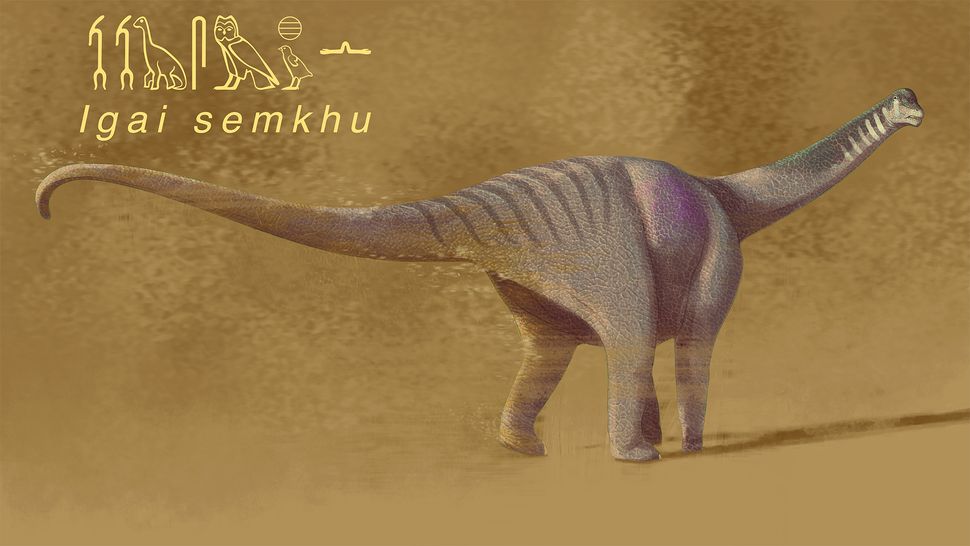After nearly five decades of obscurity, a remarkable discovery has shed light on a previously unnamed titanosaur species, buried within the Egyptian desert. In an intriguing revelation, the unveiling of this “miniature” titan, measuring a modest 33 to 50 feet (10 to 15 meters) in length, emerged in the July 2023 edition of the Journal of Vertebrate Paleontology.
This revelation has triggered significant excitement among paleontologists and dinosaur enthusiasts alike, offering a vital puzzle piece in our understanding of the enigmatic final 30 million years of the Age of Dinosaurs. This period occurred on one of the world’s most extensive landmasses – a fitting testament to the remarkable history of our planet.

The story of this unusual titan began in 1977 when German researchers unearthed its remains in Egypt’s Western Desert. These remains, however, languished in relative obscurity until recently, when a team of researchers, led by Dr. Matt Lamanna, decided to reexamine them.
The results of this reevaluation were nothing short of astonishing. The specimen, which researchers dubbed Igai semkhu, was identified as a previously unknown genus and species of titanosaur. Titanosaurs, part of the sauropod subgroup, were recognized for their plant-based diet, small heads, towering necks, and colossal, elephantine bodies.
However, during the era when Igai semkhu roamed the Earth, approximately 75 million years ago, most sauropods had already become extinct. This left the titanosaurs as the sole surviving sauropod lineage during the Cretaceous era, which spanned from 145 million to 66 million years ago.
Hot off the press, we have a new #sauropod from #Egypt, Igai semkhu!
— Jamale Ijouiher (@JamaleIjouiher) July 20, 2023
This only adds to the growing body of evidence we're developing for the Campanian–Maastrichtian of Africa. pic.twitter.com/lVg1wRSUUh
Despite their name, titanosaurs varied significantly in size, ranging from some of the smallest sauropods, comparable in dimensions and mass to a cow, to gigantic specimens rivaling the heft of humpback whales. These colossal creatures hold the distinction of being the most massive land-dwelling animals ever known to science.
Igai semkhu occupies a middle ground within this size spectrum. Dr. Eric Gorscak, a co-author of the study and paleontologist at Midwestern University, estimated the size of Igai semkhu using the recovered leg bones – the tibia and fibula. Even at the higher end of the size estimate, roughly equivalent to the length of a school bus, it would still be considered “slightly below average” in terms of titanosaur size.
Unfortunately, the available fossil evidence for Igai semkhu is rather limited, consisting primarily of leg bones and some vertebrae. This paucity of remains makes it impossible to construct a precise visual representation of what this dinosaur looked like.
Nonetheless, despite these challenges, Igai semkhu’s discovery stands out as one of the most comprehensive dinosaur fossils ever found in Africa. The African continent has historically been underrepresented in the realm of dinosaur paleontology, primarily due to the relatively recent start of excavation efforts and the inaccessibility of many Cretaceous-era fossil sites. Thick vegetation and deep desert sands have concealed numerous potential dig sites.
This scarcity of dinosaur fossils in Africa makes Igai semkhu’s contribution all the more significant. In the words of Dr. John Whitlock, a professor of Anatomy at Mount Aloysius College in Pennsylvania, who was not involved in the study, “Igai is, although still fragmentary, complete relative to the rest of the record, and is therefore a pretty significant addition to our understanding.”
The long-overdue identification of Igai semkhu offers a remarkable window into the world of titanosaurs and dinosaurs in Africa during the Late Cretaceous period. This discovery underscores the importance of continued exploration and study in regions where the prehistoric record has remained elusive for far too long. Igai semkhu’s place in the annals of paleontology promises to be a significant one, adding valuable insights to our evolving understanding of Earth’s ancient past.
